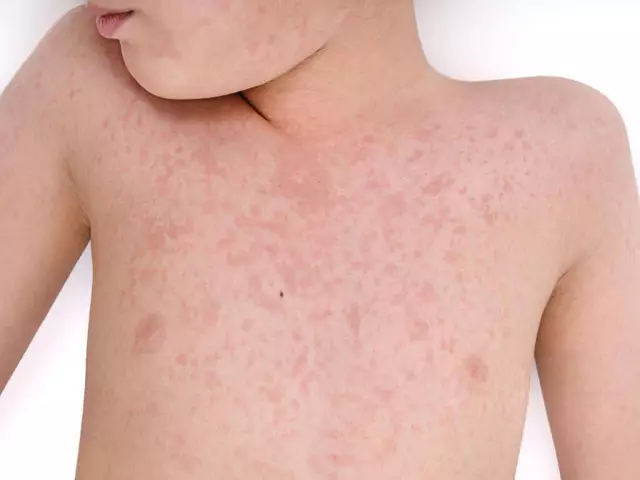- Author Rachel Wainwright [email protected].
- Public 2023-12-15 07:39.
- Last modified 2025-11-02 20:14.
Rubella
General information about the disease

Rubella is understood as an acute viral infection, which belongs to the category of so-called childhood infections, that is, it most often occurs in childhood. The very name of the disease "rubella" comes from the characteristic color of the rash, which covers the body of a sick person for several days.
Rubella has been known to doctors since the Middle Ages, and even at that time it was widespread almost everywhere. However, for centuries, scientists have believed that rubella in children is completely harmless. The connection of the disease with intrauterine infant mortality and congenital malformations in babies was proved only in the 40s of the last century, after which rubella vaccination was included in the national vaccination calendars of dozens of countries around the world.
What causes rubella and how is it spread?
Rubella is caused by a virus from the togavirus group. From person to person, it is transmitted by airborne droplets through direct contact with an infected person. Also known is the transplacental route of transmission of rubella, in which the child becomes infected while still in the womb, when the virus passes to the fetus through the placenta.
The causative agent of rubella can only exist comfortably in the human body. In the external environment, it quickly dies due to ultraviolet rays, pressure changes, insufficient humidity and high temperatures. In low temperatures, the virus, on the contrary, lives for a long time and retains the ability to reproduce for several years.
The insidiousness of the rubella virus lies in the fact that the incubation period of the disease lasts from 2 to 3 weeks. Accordingly, a sick person becomes contagious long before the first adverse symptoms appear. Note also that children may have no symptoms at all when diagnosed with rubella. As a result, one sick child often infects everyone around him, and doctors catch their eye only when children have characteristic rashes on their bodies.
Rubella outbreaks occur every 5-7 years. Annual exacerbations occur in the spring and summer, but do not pose a particular danger due to effective preventive measures. The last case of a large-scale epidemic was recorded in the 60s in North America. Then more than 20 million people fell ill, and after an outbreak of rubella, thousands of pregnant women had children with one or another congenital deformity.
Rubella types
Depending on the route of infection, rubella in adults and children is divided into two types:
- acquired rubella - proceeds in a wide variety of forms, is accompanied by the appearance of a rash on the body, but it may also have an atypical clinical picture of development, in which a rash does not form. In addition, in 30% of cases, there are no symptoms of rubella at all, which greatly complicates the correct diagnosis and provokes the spread of epidemics. Usually, the disease is mild to moderate, and patients are treated at home. Hospitalization is indicated only in the event of severe complications, which, however, are extremely rare;
- Congenital rubella is much more serious than an acquired infection. This concerns both manifestations and possible consequences, among which we can especially note the lesions of the nervous system, heart defects, disturbances in the functioning of the eyes and hearing organs.
In connection with the above, I would like to make one significant remark: rubella in adults is quite rare, since the overwhelming majority of people get sick even in childhood, and the resulting immunity lasts for life. At the moment, at least 85% of women are immune to infection by the time of reproductive age.
Rubella symptoms
The acquired form of rubella is cyclical. Rubella symptoms begin with:
- ailments;
- headache;
- short-term increase in body temperature;
- joint pain;
- the appearance of a small-spotted pink rash (appears on days 2-3 of the disease, spreads throughout the body).
Unlike measles, individual elements of the rash do not tend to drain and disappear without pigmentation or peeling. The characteristic symptoms of rubella are swollen lymph nodes in the neck and in the occipital region. Signs of fever and intoxication are either minor or completely absent. In many cases, the disease proceeds in an inappropriate form, when the symptoms of rubella in children are very weak, which leads to the impossibility of making a correct, timely diagnosis.
Rubella treatment

Rubella treatment is usually done at home. The child needs to be provided with bed rest, good nutrition, rich in vitamins, abundant drink (preference is given to juices and fruit drinks, carbonated drinks are excluded).
There is no specific treatment for rubella. Specialists monitor the child's condition, use symptomatic remedies. When complications appear, urgent hospitalization is indicated, but, as mentioned above, the need for it is extremely rare. Treatment prognosis is favorable. In most cases, rubella disappears after a few days and does not lead to serious consequences. After healing, a person acquires lifelong immunity. Medicine knows cases when rubella in adults reappeared, but these are rare exceptions due to the characteristics of the human immune system.
Rubella vaccination and isolation of infected children are used to prevent epidemics. It is very important to exclude communication between a sick child and pregnant women, since in expectant mothers without immunity, this can lead to fetal malformations.
Vaccination of the population is included in the national immunization schedule. The vaccine is given intramuscularly or subcutaneously when the child is one year old. Re-vaccination against rubella is done at the age of 6. Specific immunity appears in 100% of those vaccinated and lasts throughout life.
YouTube video related to the article:
The information is generalized and provided for informational purposes only. At the first sign of illness, see your doctor. Self-medication is hazardous to health!






